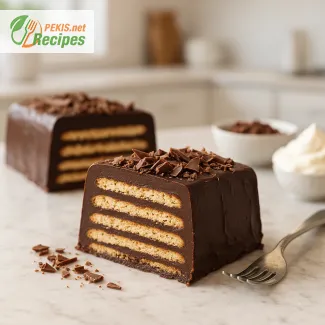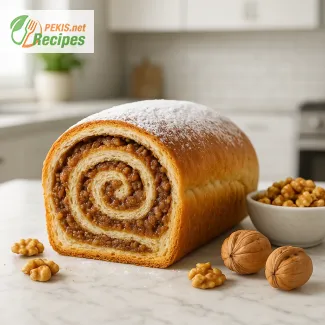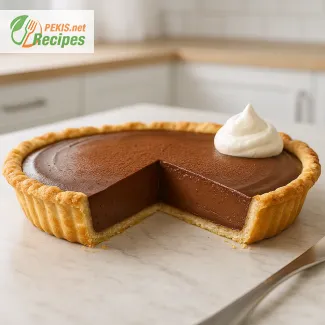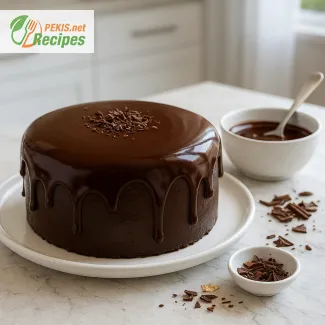
A timeless celebration dessert made simple and delightful
Discover how to make the perfect communion cake with ease and elegance
In a world where time is a luxury and celebrations are moments we hold dear, finding a cake recipe that balances simplicity, refinement, and symbolism is a rare delight. This Easy Communion Cake Recipe for Busy Bakers has been thoughtfully crafted for those who want to honor a sacred milestone like First Holy Communion with a homemade touch — but without the complexity that often accompanies traditional celebration desserts.
Whether you're a seasoned home baker or someone who steps into the kitchen only for special occasions, this recipe will speak to your heart and hands. The communion cake is more than just a dessert — it’s a centerpiece of reverence and joy, reflecting the importance of the sacramental event. With gentle flavors, delicate textures, and a polished presentation, it conveys a message of purity, grace, and family unity.
What sets this recipe apart is its accessibility. Even with a packed schedule, you’ll find that this cake can be made with minimal effort while still delivering a bakery-quality experience. The method is designed to save time without compromising on taste or presentation, offering busy bakers a way to create something truly memorable. You won’t need any specialized equipment or advanced decorating skills — just a few fresh ingredients, a calm morning or afternoon, and a bit of joy in your hands.
The flavor profile is elegantly balanced. Think of a moist, vanilla-scented sponge that melts on the tongue, complemented by a light cream filling and a smooth, white frosting that symbolizes the sanctity of the occasion. This combination isn’t too sweet, making it ideal for children and adults alike, and easily customizable with delicate flavor variations like almond, lemon, or coconut to suit your family’s preferences.
Visually, the communion cake exudes classic simplicity. White or pale pastel tones dominate the aesthetic, often finished with edible decorations, sugar crosses, or gentle florals. Its understated design allows the spiritual significance of the celebration to shine through, while still offering a sense of festivity and joy. It’s an ideal match for events held at home, in church halls, or at garden gatherings — adaptable, beautiful, and delicious.
The emotional resonance of baking a communion cake cannot be overstated. Preparing it yourself adds a personal and heartfelt touch to the day, making it not just about the flavors, but about the act of giving and sharing. It’s a meaningful way to contribute to a loved one’s spiritual journey, and a chance to create lasting memories for the entire family.
Many busy parents, godparents, and family friends often find themselves caught between wanting to contribute something special and homemade, and needing a solution that doesn’t overwhelm their schedule. This recipe solves that exact dilemma — it respects your time while elevating your celebration.
As you prepare to mark this significant event, consider how a homemade cake — simple yet elegant — can transform your table and hearts. This communion cake is a humble yet profound gesture of love, a beautiful way to bring flavor, tradition, and a little sparkle to the occasion.
Whether served after mass with a glass of juice or as the highlight of an afternoon celebration, this cake delivers not only a satisfying bite but a sense of completion. A moment where sweetness meets spirituality, and where tradition finds its place in your busy, modern life.
This recipe has been created to help you honor sacred moments effortlessly, offering a culinary expression of faith that’s both easy to achieve and a joy to share. With a few key ingredients and some thoughtful preparation, you’ll soon have a communion cake that looks as beautiful as it tastes — a cake made not just with butter and sugar, but with intention, faith, and love.
- Preheat the oven to 175°C (350°F). Grease and line a 20 cm (8 inch) round cake pan with parchment paper.
- Cream the butter and sugar in a large mixing bowl until the mixture is pale and fluffy. This step should take about 3–4 minutes using an electric mixer.
- Add the eggs one at a time, beating well after each addition. Stir in the vanilla extract.
- In a separate bowl, sift together the flour, baking powder, and salt.
- Add the dry ingredients to the butter mixture in three additions, alternating with the milk. Start and end with the dry ingredients. Mix until just combined — do not overmix.
- Pour the batter into the prepared cake pan and smooth the top.
- Bake for 30–35 minutes, or until a toothpick inserted in the center comes out clean. Remove from the oven and allow to cool in the pan for 10 minutes, then turn out onto a wire rack to cool completely.
- While the cake cools, prepare the frosting. Beat the butter until creamy, then gradually add powdered sugar. Add the vanilla extract and milk, beating until the frosting is smooth and spreadable.
- Once the cake is completely cool, frost the cake evenly on all sides. Use a spatula to create smooth or soft waves, depending on your preferred finish.
- Decorate the cake with edible pearls, a sugar cross, or flowers to suit the communion theme. Let the frosting set for 15–20 minutes before slicing and serving.
Creative ways to elevate your communion cake
Tips and ingredient swaps that enhance both taste and texture
The traditional communion cake is a beautiful blend of simplicity, elegance, and symbolism — yet even the most cherished recipes leave room for subtle improvement and personal flair. Whether you're aiming to enhance the flavor profile, adjust the texture, or cater to dietary needs, this guide explores clever enhancements and common pitfalls to help you create a cake that's not only memorable but uniquely yours.
Flavor upgrades that make a lasting impression
A classic communion cake features vanilla sponge and a light buttercream frosting, but that doesn’t mean you can’t innovate while maintaining the cake’s sacred tone. Here are some small changes that deliver noticeable results:
- Add citrus zest (lemon or orange) to the batter. This brings a bright freshness that lifts the entire cake. Just 1 tsp of zest is enough to make the flavor more vibrant without overpowering it.
- Infuse the milk used in the batter with a cinnamon stick or a few crushed cardamom pods before cooling it and adding it to the mix. This technique adds a subtle warmth and depth of flavor.
- Replace vanilla extract with almond extract or combine both. Almond is often associated with celebration cakes and adds a sweet, nutty essence that aligns beautifully with religious themes.
- Add a thin layer of fruit jam between the sponge layers. Raspberry, apricot, or strawberry work best and introduce a tangy contrast to the buttery sweetness of the frosting.
Why homemade communion cake tastes better
Store-bought cakes often fall short in both texture and meaning. A cake made at home allows complete control over the quality of ingredients, and the absence of preservatives ensures a fresher, more natural taste. More importantly, baking a communion cake yourself allows you to express love and care — two values that resonate deeply with the spiritual significance of the celebration.
Common mistakes to avoid during preparation
Even the simplest recipes can go awry without attention to detail. Here are frequent issues and how to avoid them:
- Overmixing the batter can lead to a dense, rubbery texture. Mix until ingredients are just combined.
- Incorrect oven temperature may cause uneven baking or dry edges. Always preheat the oven and use an oven thermometer for accuracy.
- Skipping the sifting of dry ingredients can result in a lumpy batter and uneven texture. Sifting also helps to incorporate air, contributing to a light, fluffy cake.
- Using cold ingredients can result in curdled batter and uneven mixing. Let all ingredients come to room temperature before starting.
Healthier alternatives that don’t compromise on taste
If you're looking to make your communion cake a bit more nutritious while keeping it delicious, consider these adjustments:
- Substitute half of the all-purpose flour with whole wheat pastry flour. It maintains softness but adds fiber and a mild nutty flavor.
- Use Greek yogurt instead of some of the butter for a lighter texture and a slight tang.
- Replace some sugar with mashed bananas or unsweetened applesauce. This naturally sweetens the batter while adding moisture and nutrients.
- Opt for a light cream cheese frosting instead of a full buttercream to cut down on saturated fat and calories without sacrificing flavor.
Decorating with purpose and elegance
Presentation is important for a cake that symbolizes purity and celebration. Here are some ways to elevate its appearance while keeping the process simple:
- Use a cake comb or offset spatula to create elegant frosting textures.
- Decorate with edible flowers, sugar crosses, or fondant doves to keep the spiritual theme central.
- Add pearl-like sugar balls around the base for a polished finish that’s suitable for formal events.
- Consider personalized name tags or date toppers for a meaningful touch.
Ingredient enhancements that affect moisture and texture
Changing certain ingredients slightly can result in a better overall texture. Here are some tried-and-true tweaks:
- Swap out 1 tbsp of flour for cornstarch to soften the crumb structure.
- Use cake flour instead of all-purpose flour for an ultra-tender sponge.
- Replace regular milk with buttermilk to add tang and boost leavening for a lighter cake.
- Adding an extra egg yolk can enrich the batter and create a silkier crumb.
Making the recipe allergy-friendly
With dietary restrictions on the rise, it’s helpful to know how to adapt your recipe:
- Use gluten-free all-purpose flour blend with xanthan gum for a celiac-safe option.
- Substitute eggs with chia or flaxseed gel (1 tbsp seeds + 3 tbsp water per egg).
- Swap butter and milk for vegan alternatives like oat milk and plant-based margarine.
While tradition gives this cake its sentimental and spiritual value, enhancing the original recipe allows it to grow with your family’s tastes and needs. Each adjustment — from a pinch of zest to a healthier frosting — is a way to personalize the experience, honor the moment, and serve something that’s not only beautiful but made with intention. In the end, it’s these little touches that make your communion cake more than just a dessert — they make it a memory.
Allergens present:
- Gluten (wheat flour)
- Dairy (milk, butter)
- Eggs
Substitution tips for allergies:
- Replace all-purpose flour with gluten-free flour blend with added xanthan gum.
- Use plant-based milk (like oat or almond) and dairy-free margarine for a lactose-free version.
- Swap eggs with 3 tbsp aquafaba (chickpea brine) or 1 mashed banana per egg.
- Vitamin A: 350 µg – supports vision and immune health
- Calcium: 55 mg – essential for bone strength
- Iron: 1.1 mg – supports oxygen transport in blood
- Vitamin D: 0.8 µg – helps regulate calcium and phosphate in the body
- Potassium: 95 mg – supports muscle and nerve function
- Vitamin E: 1.2 mg – protects cells from oxidative stress
- Selenium: 5 µg – supports immune function and thyroid regulation
- Beta-carotene (from eggs and butter): 140 µg – supports healthy skin and immunity





